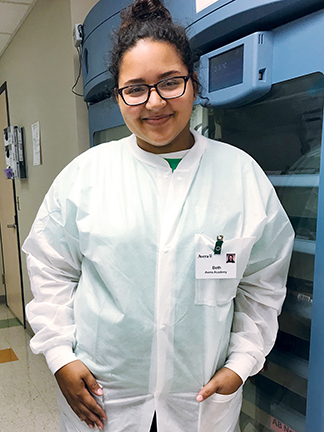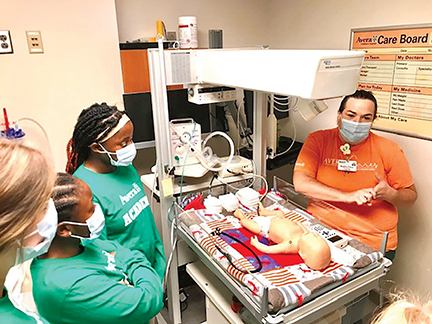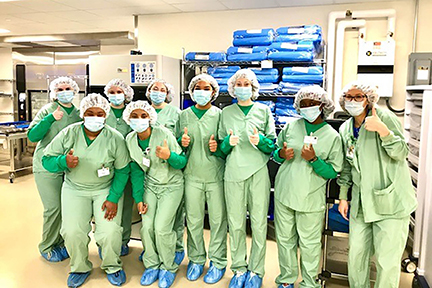By KATHLEEN NELSON
Elizabeth West walked into her high school guidance counselor's office three years ago with a vague notion that she might want to work in a lab someday. But no one in her family had attended college, so she was unaware of the challenges and opportunities
in pursuing a postsecondary education.

Elizabeth West, an alumni of Avera Academy, works as an imaging services assistant for Avera McKennan Hospital & University Medical Center in Sioux Falls, South Dakota, while she pursues coursework in medical sonography at nearby Southeast Technical
College. Avera Academy opens pathways to health care careers for high school students.
Credit: Avera Health
She walked out with information on Avera Academy, a fledgling two-semester program offering seniors in the Sioux Falls School District in South Dakota the chance to earn credit at nearby Southeast Technical College and shadow employees at Avera McKennan
Hospital & University Health Center.
She decided to apply because Avera would pay all expenses for the courses which yielded college and high school credits simultaneously. Since then, she has graduated from high school, been accepted into a selective sonography program and started working
as an imaging services assistant at Avera while she finishes her degree program.
And West and the 70-plus participants who are enrolled in or alumni of Avera Academy have earned much more. "What I see isn't just the hard outcomes but how the students grow from the exposure to so many careers and the confidence they build," says Shantel
Krebs, administrator of Avera Academy.
Avera started the program in 2019 as a way to honor and continue the charism of its founders, the Benedictine Sisters of Yankton and the Sisters of the Presentation of the Blessed Virgin Mary. Avera funds the entire cost of the program through its Community
Partnership Program, which provides sponsorship and financial support for organizations and programs that promote health and wellness and civic betterment.

Avera Academy students visit the simulation lab at Avera McKennan Hospital & University Medical Center. The two-semester Avera Academy program offers high school seniors in Sioux Falls, South Dakota, the opportunity to explore health care careers
while earning credit from nearby Southeast Technical College.
Credit: Shantel Krebs/Avera Academy
"What better way to continue the mission than with young adults going into the workforce?" Krebs says. "The program reaches out to a demographic not familiar with health care careers."
Now in its fourth year, Avera Academy accepts 24 students entering senior year at four public high schools in Sioux Falls. Between 50 and 70 apply annually, submitting a six-page application, an essay, transcripts and letters of recommendation. Then,
an eight-member selection committee made up of representatives from the school district, the community college and Avera reviews the material, giving preference to applicants who are first-generation Americans, from a low-income household or who are
determined to be the first member of their family to attend college.
After acceptance, students spend Monday through Thursday mornings attending dual-credit courses at Southeast Tech and return to their high schools for the afternoon. Each student also meets weekly with Krebs, who fills them in on the department they will
visit that Friday. She explains a bit about the different skill sets and preparations necessary to perform the work they will observe and gives a brief rundown on terminology they might hear and what to expect.
Through the course of the two-semester program, students visit 37 clinical and administrative departments throughout Avera McKennan. Departments may host one student at a time or small groups of students.

High school seniors in Avera Academy give a thumbs up for the surgery technician rotation they just completed at Avera Specialty Hospital. To learn about the variety of careers in health care, academy students spend a day in each of 37 clinical, administrative
and support departments throughout Avera Health's facilities in Sioux Falls, South Dakota.
Credit: Shantel Krebs/Avera Academy
"It's really eye-opening to experience so many different career paths that a lot of people don't get to discover," West says. "There were a lot of behind-the-scenes careers that you'd never think about, especially in surgery."
Her personal "aha" moment occurred in radiology, observing technicians giving sonograms. "I had no idea how involved it was, but it touched me," she says. "That visit definitely jump-started my interest."
West, 20, graduated from high school in 2020 with 12 health care credits, which gave her an advantage when she applied and was accepted as one of only 20 students in the associate degree program in diagnostic medical sonography at Southeast Tech.
While she completes her studies as a part-time student, she is working part-time at Avera as an imaging services assistant. Avera pays part of her tuition — a benefit it offers all employees. Though she assists with nuclear imaging, MRIs, CT scans
and interventional radiology, West's goal is to become an ob-gyn sonographer.
Three years ago, "I had a vague career path, but this program changed it completely," she says. "The program helped make my goal a reality."
West is one of 29 program participants employed at Avera. Almost 90% of her fellow classmates from the 2019-20 Avera Academy class pursued health care careers or health care education. In the last two classes, Krebs says, 100% pursued health care careers
and are either working full-time for Avera or studying to become doctors, nurses and technicians. Of the final group, Avera is funding 100% of nine students' tuition.
About 35% of the students from Avera Academy continue at Southeast Tech to complete associate degrees or certificate programs. Others go into nursing or premed programs at South Dakota State University, the University of Sioux Falls or other in-state
universities.
An unexpected but welcome outcome, Krebs says, is that some students start the program unfamiliar with the health care system and are suspicious of it. They learn about preventive medicine, vaccinations and cancer screenings and "they pass it on to their
families, connecting them to doctors and our resources."
The focus, though, remains on finding a career in health care for young adults who might not otherwise consider it, or to find the right career for those with a general interest in health care. "Many would likely not have pursued higher education and
instead have worked for the large retail outlets or at one of the meat-processing plants," Krebs says, "But we feel good that we are making a connection for their continued education and career. We want to make them feel a part of our family."